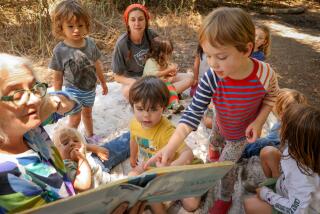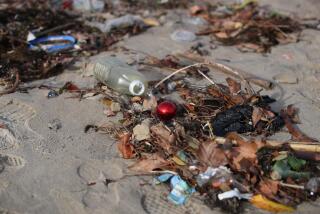Mother Goose Meets Mother Nature : Preschool: At the Young Naturalist Center, toddlers learn about the environment in a back yard paradise.
- Share via
It is a tropical Brazilian rain forest complete with howler monkeys and jaguars.
It is a desert plain where chipmunks and ground squirrels hibernate. And in the spring, it is a garden of wild flowers.
It is a place where Australian aborigines live.
And it is Marti Harmon’s Studio City back yard.
Since 1983, Harmon, 46, has used her back yard to operate the Young Naturalist Center--an alternative to traditional day care or preschool. Harmon is an environmental educator who incorporates an appreciation for nature into the everyday curriculum of her pre-kindergarten children.
“It’s not like bringing your kids here is just some yuppie thing to do,” said Abbie Phillips, whose 5-year-old son, Ben, attends the school. “Young children need to know about the environment and what’s happening to it.”
Harmon, a member of the National Audubon Society, dreams of incorporating similar environmental techniques into the classroom curriculum of young children throughout the country. Recently, Harmon shared her philosophy with educators in a native American community in South Dakota.
“Someday, I would like to see all children learn by appreciating the world around them,” Harmon said. “Just like the children here appreciate this big back yard and the world it represents.”
Just one block east of busy Coldwater Canyon Avenue, the Young Naturalist Center is a serene place surrounded by a 6-foot cedar fence that allows the children to leave an increasingly hectic world behind. Butterflies and hummingbirds flit about and classical music wafts overhead.
Harmon’s back yard is a child’s paradise.
Juniper trees stand bunched together in one corner of the yard, completely shading a classroom-sized grassy area. This is the rain forest.
A basket of stuffed animals is nearby. These are the toucans, howler monkeys, jaguars and marpho butterflies of the rain forest.
It is 2 p.m. and nap time has just ended.
Eight children tumble from the house and sit on the porch to lace up their tennis shoes. They have dirt smudges on their knees. Their clothes have a used played-in look. They have healthy complexions and when Harmon gives the OK they race to the rain forest.
“I’m a howler monkey, I live in the trees!” says 4-year-old Joanna.
“I’m a jaguar, strongest animal of the rain forest!” 4-year-old Will responds.
Harmon, who earned her master’s degree in human development at Pacific Oaks College in Pasadena, walks over to the group and picks up a stuffed rabbit. Someone has accidentally left him perched in the tree.
“Where does the rabbit go, does anyone know?” she asks and a 5-year-old named Ben jumps down from the tree.
“He lives in the ground in a temperate forest,” Ben says, setting the rabbit gingerly in a child-made burrow. “We better put him down here so he’s safe.”
It is a world of imagination and make-believe with a purpose.
According to Dianne Philibosian, a Cal State Northridge professor who serves on the governor’s commission for child care, Harmon’s Young Naturalist Center has several benefits for young children.
Philibosian said that such a center offering hands-on experience teaches children how to interact in an interdependent world. It also heightens the children’s sense of fantasy, she said.
“It is a wonderful way for them to categorize animals, to learn the difference between fish and monkeys and ground squirrels,” said Philibosian, who has never visited the Young Naturalist Center but is familiar with Harmon’s techniques. “There are not enough schools doing this kind of thing.”
Philibosian added that the most important lesson children can learn from such a center is the value of other forms of life.
Harmon agrees.
“The children feel like they are playing all day, but in fact they are learning a respect for their environment and the environment of other cultures,” said Harmon, who has two teen-age children. “This way it is integrated into their playtime and they learn it much more quickly than if they were sitting in a classroom.”
Before the children tire of the rain forest, Harmon steers them toward an organic vegetable garden next to the house. The garden is a flourishing assortment of lettuce, oregano, radishes and carrots. At snack time, the children eat what they harvest.
“We use no pesticides,” Harmon said, pointing to a tiny wooden table covered with potting soil and red and blue shovels. “I think there is something about a child getting his hands in the dirt that keeps the snails away.”
Later in the day, Harmon hands each child a wicker basket and asks them to walk through the Silent Forest and pick herbs and nuts for the baby Australian aborigines. The Silent Forest is an area made up of an aging blue spruce tree, elderberry trees and a towering paper mulberry tree. Here, the children must play and talk very quietly.
“This is a place where they can reflect and be in tune with themselves,” Harmon said. “It’s very important in the world that we live in that they take time to reflect in this kind of surrounding.”
Once the herbs and nuts are collected, Harmon whisks the children to an orange nylon tent near the house. Different-colored plastic dolls fill the tent and Harmon hands each child one. These are the aborigines.
“Can I be a daddy and carry the baby on my back like they do in Australia?” 5-year-old Alex asks? And Harmon’s assistant, Cheryl Osborne, takes a section of a white sheet and wraps a doll on Alex’s back, where it remains until Alex’s mother comes to pick him up.
At 3 p.m., the children are ready for arts and crafts.
All art projects are done in three-dimensional form and involve materials that can be recycled and natural materials. Today, the children are designing their own rain forests, using tempera nontoxic paints to color empty paper-towel rolls and bunches of dried straw.
When their hands become smudged with paint or mud, the children run across the yard to a large bucket of water and rinse them off. This way, Harmon is teaching them to conserve water.
The parents see Harmon as a living anachronism of the 1960s.
The children see her as the world’s best grown-up.
She dresses in tennis shoes, sweat pants and colorful oversized T-shirts. Her brown curly hair loosely frames green eyes that are every bit as alive as those of the children. When it’s time to crawl on the ground and learn what it’s like to be a ground squirrel, Harmon leads the pack.
Bonnie Thompson-Norman is a parent who interviewed several people at various preschool centers before deciding on the Young Naturalist Center.
“So many of the schools have this strict emphasis on reading and writing and kindergarten preparedness,” Thompson-Norman said. “They make getting ready for kindergarten like getting ready for college. Harmon hasn’t forgotten that kids like to play.”
And somehow amid all the play time, Thompson-Norman said her son is learning more than his neighborhood peers.
“He comes home and tells me about desert plains and rain forests and the problems with malathion spraying,” Thompson-Norman said of her 5-year-old son, Paul. “His reading and writing are coming along beautifully and he doesn’t feel all stressed out about kindergarten starting later this year.”
Parents are willing to pay a steep price for Harmon’s center. She charges $6 an hour. If a child were to attend the center three full days a week, it would cost $576 per month. Consequently, most of the parents do not work full time and only leave their children with Harmon a few days each week.
Like everything else, discipline is handled in a unique way at the Young Naturalist Center. Children are never benched or set apart from their peers. Instead, Harmon and afternoon teacher Pam Hayward encourage the children to talk over their differences.
“We are teaching the kids to be autonomous rather than running to adults and tattling on another child,” said Hayward, a licensed marriage-family counselor. “They have words to work things out verbally. It makes them very gentle.”
And all children must follow Harmon’s only house rule: No violent play. A child must not do anything that hurts the environment or another child.
This applies to activities indoors and out. Inside Harmon’s house, dozens of pillows are tossed on a hardwood floor and reading shelves overflow with children’s environmental books.
“The kids are so mellow here compared to children at other day-care centers” that she interviewed, said Phillips, who also brought her daughter, Sadie, to the center and has known Harmon for five years. “They have verbal tools and can really express themselves.”
Phillips said she and her husband, a child psychiatrist, have spent many hours wondering why Harmon is so successful with the children.
“But the answer is really quite simple,” Phillips said. “Marti is still a kid herself.”
More to Read
Sign up for Essential California
The most important California stories and recommendations in your inbox every morning.
You may occasionally receive promotional content from the Los Angeles Times.













